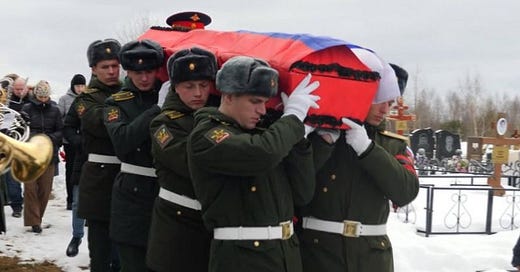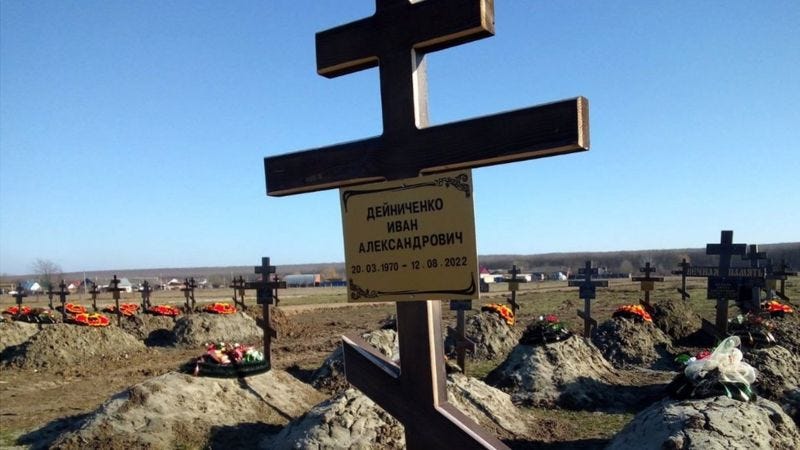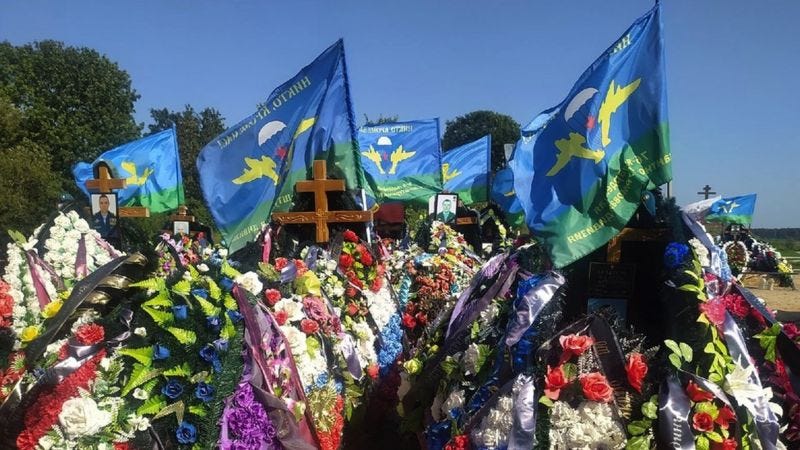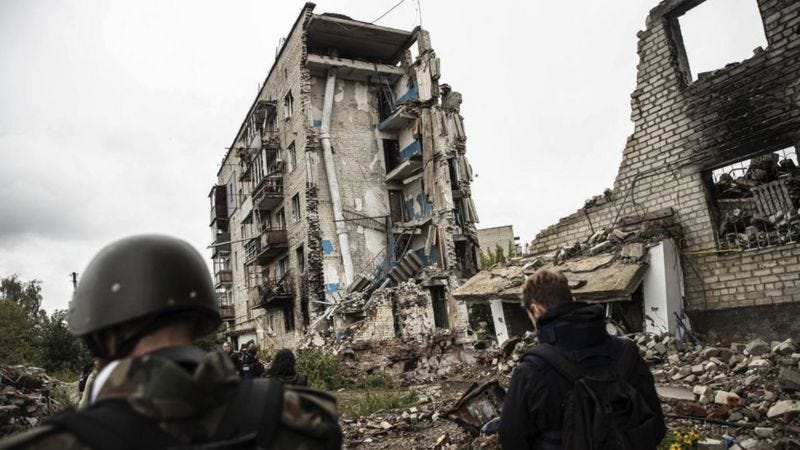11,000 and counting. What do we know about Russian losses in Ukraine as of January 2023
The BBC Russian Service has managed to establish the names of more than 11 thousand Russian soldiers who have died in the war in Ukraine, 539 of whom were newly mobilised.
By Olga Ivshina.
Since the start of the war, BBC Russian Service, with the media outlet ‘Mediazona’ and a team of volunteers, has been keeping count of the losses of Russian troops in Ukraine. As of 6th January, we have been able to confirm the details of 11,009 dead soldiers and officers.
We include only reported deaths that we have been able to confirm, so the collected data does not necessarily reflect the full extent of the casualties. We think that our list contains at least 40-60 per cent fewer names than the actual number of soldiers that have been buried in Russia. We came to this conclusion having studied cemeteries in over 60 Russian settlements.
Consequently, at a conservative estimate, the Russian army and national guard casualties may be over 22,000 people.
More generally, Russian losses (including deaths and anyone missing or out of action due to injury) may be conservatively estimated to be at 99,000 people.
This figure is based on the observations of the United States Naval Institute, which estimates that for every Russian soldier killed in Ukraine, there are another three and a half injured. This figure does not include those who fought on Russia’s side as part of the ‘People’s Militia’ of Donetsk and Luhansk.
The losses of mobilised soldiers
From open sources, we know about the deaths of 539 mobilised Russians. This number does not include soldiers who died in the shelling by Ukrainian forces of Makiivka on 1st January.
By 3rd January 2023, the Russian Ministry of Defence recognised the deaths of 89 Russians in Makiivka. Both Ukrainian journalists and Russian pro-military bloggers say that the number of those killed potentially extends into the hundreds. Since the victims’ names are not yet known, we do not take this data into account in our calculations.
Based on open-source data, we have been able to identify the names of nore than 500 mobilised soldiers who have died in Ukraine since October. A further 36 died on Russian territory – allegedly due to heart problems, alcohol abuse, or other unforeseen circumstances.
The number of Russians dying at collection centres for recruits continues to grow. Over the past two weeks, three deaths have been reported in training centres for those mobilised in Russia.
The actual number of losses among mobilised soldiers may be far greater since many reports about soldiers killed in Ukraine since October do not indicate the nature of their service within the armed forces. As such, it is sometimes impossible to know whether military personnel served as contractors, volunteers, or were mobilised.
According to mobilised Russian soldiers, their units continue to suffer significant losses for many different reasons. These include intense and accurate artillery strikes by Ukrainian forces, poor coordination, signalling and cartographic issues, as well as inadequate training for new recruits.
More on the causes of significant losses to mobilised soldiers can be read here.
Regional inequalities
Over the last month, the number of identified deaths of military from the Sverdlovsk region has rapidly increased (357 people), of which 102 were mobilised recruits. The average age of the victims is 30-35 years, with many having resided in small towns and villages.
In terms of the number of confirmed casualties, Krasnodar region has been in first place for two months, with 494 dead. 40 per cent of the losses from this region were not reported in the media or on social media. News of their deaths only emerged by observing burials in local cemeteries. Local volunteers regularly visit churchyards and post photos of graves.
In second place for losses is Dagestan (373 people), followed by Buryatia (362 people). By contrast, only 63 people from Moscow are known to have died, even though the capital’s inhabitants make up almost 9% of the country’s population.
Having studied the data collected by the BBC, ‘Mediazona’ and volunteers, sociologists concluded that the distribution of losses reflects the economic inequality between regions in the country.
On the one hand, men from Russia’s ethnic minority provinces who go to the front die more frequently than those from ‘Russian’ regions. On the other hand, in absolute numbers, most of the dead soldiers are still ethnic Russians.
In many parts of Russia, where there is little chance to improve your social standing, contracted military service is one of the few ways to guarantee a stable income.
A more detailed sociological analysis of losses can be read here (in Russian).
Prisoners, volunteers, and infantry
Over the past two months, there had been many reports on the deaths of prisoners who fought in Ukraine as mercenaries in the private military group Wagner.
The BBC managed to identify the names of 240 convicts who have died in Ukraine, with the number growing fast.
At the end of December, military pensioner Vitaly Votanovsky discovered a cemetery dedicated to Wagner Group mercenaries in Krasnodar region, where prisoners who died in Ukraine were being buried. On 20th December, the activist counted 47 graves, on 1st January - 96 graves, with over a hundred as of 2nd January.
The fact that Wagner Group personnel were being buried in the cemetery was recognized by the company’s founder, businessman Yevgeny Prigozhin. Having verified the data for 67 of those buried, the BBC found that all of them were convicts who should be serving sentences in prison. Many of the convicts were sentenced for very serious offences, including crimes against close relatives.
The NGO ‘Rus Sidyaschaya’ (‘Russia Behind Bars’) estimated that the number of prisoners recruited to fight in the war in Ukraine has exceeded 30,000 people.
According to BBC sources on the front line, Ukrainian positions are now being stormed predominantly by Wagner units, as well as others consisting of volunteers.
In many cases, these volunteers signed short-term contracts with the Ministry of Defence and Rosgvardiya (National Guard of Russia) after the war began. Many of them completed only three to 10 days of training before being sent to the front. The number of dead volunteers continues to grow, now making up 13 per cent of the total confirmed losses.
Volunteers serve in different units of various branches of the Russian armed forces, but we assign them as a separate category to compare with losses from certain units, particularly the Airborne Forces (paratroopers).
In absolute numbers, volunteer casualties (1,433 people) have already exceeded the established losses of paratroopers (1,425 people). This is most likely due to the fact that airborne units, consisting of contract servicemen, suffered serious losses through injuries and deaths in the first months of the war. After this, airborne units were forced to withdraw from the front line to regroup.
The nature of the fighting has also changed. A series of rapid assaults and amphibious attacks were replaced by protracted positional fighting, in which the main burden fell on motorised infantry. The infantry now accounts for 16 per cent of all established losses.
Losses among elite forces
One of the reasons for the significant increase in losses amongst volunteers and mobilised soldiers is the depletion of the personnel from the most elite units of the Russian army and Rosgvardiya.
Units of the Airborne Forces, Russian Marines as well as Special Forces suffered serious losses in the first months of the war when they were thrown into battle without the support of heavy weaponry and artillery.
For example, according to data seen by the BBC, in just two days of fighting for the Gostomel airport near Kyiv, Russia saw 50 paratroopers killed on the 3rd and 6th of March. Among them were two majors, the commander and deputy commander of the 31st Air Assault Brigade based in Ulyanovsk.
The actual death toll in these battles may be higher since we rely only on open-source information. The Russian Ministry of Defence has not disclosed the number of casualties sustained during the storming of Gostomel airport.
On 6th March, the elite 155th Marine Brigade lost a minimum of 21 people in a single day of fighting for the village of Moshun in Kyiv region.
GRU Special Forces have also suffered serious losses. Based on open sources, we were able to establish that the 24th Special Forces brigade from Novosibirsk lost 74 personnel in Ukraine. Among them are nine officers with the rank from lieutenant to lieutenant-colonel. To compare, during the 10 years of war in Chechnya, Special Forces’ regiments lost 10 personnel in total.
Deaths of commanders
Of the 11,009 identified Russian soldiers that have died in Ukraine, 1,577 (approximately 15 per cent) were officers. Among them were four generals and 52 colonels. The number of losses among Special Forces officers is especially high in both GRU as well as Rosgvardiya units.
Junior officers in the Russian army have particularly suffered heavy losses. They are the ones responsible for making the key tactical decisions during combat. Most of these soldiers are still young and inexperienced, with many often receiving the rank of lieutenant at 21-22 years old. However, these junior officers need to decide how to achieve the respective goals set out by their commanders for the battle.
According to experts, Russia entered the war with an excess of military equipment in the armed forces and a severe shortage of trained personnel. As a result, commanders were forced to lead the soldiers as sergeants, personally leading units, instead of directing the fighting through subordinates.
What is known about the losses in the ‘people’s republics’ of Donbas?
The total figure of Russian losses increases significantly if you include those who fought against Ukraine as part of the "people's militia" of Donetsk and Luhansk.
On 22nd December 2022, the authorities of the self-proclaimed DPR acknowledged the deaths of 4,176 servicemen. However, in later reports, DPR officials stopped publishing casualties data. The self-proclaimed LPR has not reported its losses, however, based on available sources, the figure can be put at over 1,200 people.
In addition, the BBC found more than 4,300 messages and posts on social media of people who are looking for male relatives believed to be in the ranks of the "people's militia" but have not been in contact for a long time. Some of them have already been killed and their bodies transported to Russia.
Even taking into account verified data only, the total number of casualties fighting on the Russian side exceeds 28,000.
If we include those injured, a total loss of over 126,000 people can be attributed to pro-Russian forces over ten months since the war began.
According to the US, counting both dead and injured personnel, Russian losses in Ukraine have exceeded 100,000 people.
The Ukrainian General Staff puts Moscow’s losses at more than 100,000 people. Russia’s Ministry of Defence last reported its losses on the 21st of September, announcing the deaths of 5,937 people.
How we get our data
In Russia, names and photographs from burials of the deceased are published daily. Usually, names are announced by heads of Russian regions or representatives of regional governments, local media, schools and places of learning where the deceased used to study, as well as by family members.
The BBC, ‘Mediazona’, and a team of volunteers studies this data and adds it to a database which we have run since the start of the Russian invasion of Ukraine.
Read this story in Russian here.









